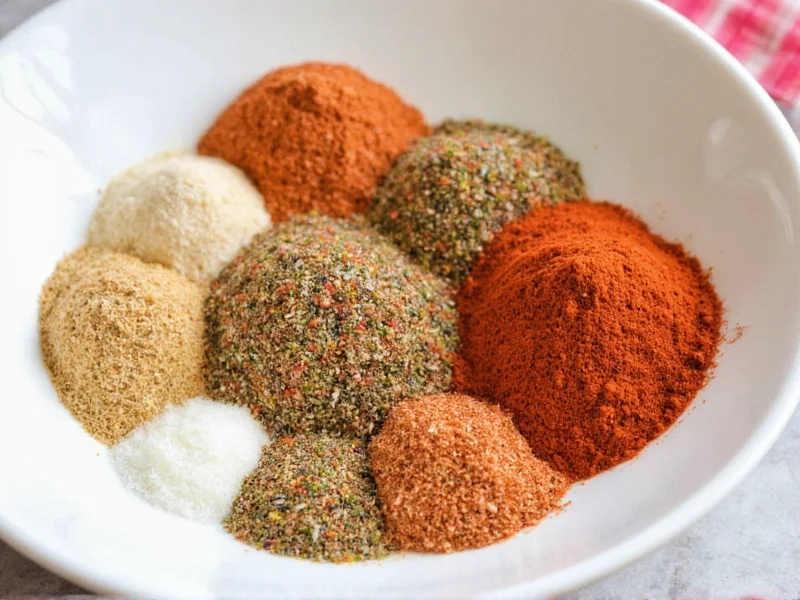When you're in the middle of cooking and realize you've run out of Cajun seasoning, knowing reliable substitutes can save your recipe. This versatile spice blend—essential for authentic Louisiana cooking—combines heat, earthiness, and aromatic herbs. Understanding what creates Cajun seasoning's distinctive flavor profile allows you to create effective replacements using pantry staples.
What Makes Cajun Seasoning Unique
Cajun seasoning originated in rural Louisiana among Acadian settlers and features a distinctive balance of heat and earthy flavors without tomato or citrus elements common in Creole seasoning. The core components typically include paprika (often smoked), garlic powder, onion powder, cayenne for heat, black pepper, and dried herbs like thyme and oregano. Unlike many commercial blends, authentic Cajun seasoning contains no salt, allowing cooks to control sodium levels separately.
Top 5 Cajun Seasoning Substitutes
When selecting a substitute, consider your recipe's requirements and available ingredients. The following options provide varying degrees of similarity to traditional Cajun flavor:
| Substitute | Ratio | Best For | Flavor Notes |
|---|---|---|---|
| Creole Seasoning | 1:1 | All-purpose replacement | Slightly more herbal with possible citrus notes |
| Homemade Blend | 2tbsp paprika, 1tbsp garlic powder, 1tbsp onion powder, 1tsp cayenne, 1tsp thyme, 1tsp oregano, 1tsp black pepper | Most recipes requiring authentic flavor | Closest match when smoked paprika used |
| Old Bay Seasoning | 1:1 (reduce salt) | Seafood dishes only | More celery salt, less heat, different herb profile |
| Adobo Seasoning | 1:1 (add cayenne) | Latin-inspired dishes | Contains cumin, more garlic-forward |
| Smoked Paprika Blend | 2tbsp smoked paprika, 1tbsp garlic powder, 1tsp cayenne | Quick fix for smoky dishes | Lacks herbal complexity but provides base flavor |
Creating Your Own Cajun Seasoning Substitute
For the most authentic replacement, making your own blend ensures freshness and control over heat levels. The basic formula follows:
- For mild version: Combine 2 tablespoons sweet paprika, 1 tablespoon garlic powder, 1 tablespoon onion powder, ½ teaspoon cayenne pepper, 1 teaspoon dried thyme, 1 teaspoon dried oregano, and 1 teaspoon freshly ground black pepper
- For traditional heat: Increase cayenne to 1 teaspoon and add ½ teaspoon white pepper for authentic Louisiana kick
- For smoky variation: Substitute regular paprika with smoked paprika and add ¼ teaspoon chipotle powder
Store homemade blends in an airtight container away from light and heat. Properly stored, your substitute will maintain potency for 3-4 months—significantly longer than commercial blends which often contain anti-caking agents that degrade flavor over time.
Recipe Adjustments When Substituting
Understanding how different substitutes affect your dish helps prevent flavor imbalances. When using alternatives to traditional Cajun seasoning:
- With Creole seasoning: Reduce added salt by 25% since many Creole blends contain salt
- With Old Bay: Add ¼ teaspoon cayenne per tablespoon to compensate for lower heat level
- With adobo: Omit additional garlic and cumin from your recipe to avoid overpowering flavors
- With homemade blends: Bloom spices in 1 tablespoon oil before adding liquids to maximize flavor extraction
For gumbo or étouffée, where Cajun seasoning forms the flavor foundation, the homemade blend provides the most authentic results. In grilled meats or roasted vegetables, smoked paprika variations work exceptionally well. Seafood boils benefit from Creole seasoning substitutions which complement shellfish naturally.
When Substitutions Won't Work
While most recipes tolerate substitutions well, certain traditional Louisiana dishes require authentic Cajun seasoning for proper flavor development. Avoid substituting in:
- Authentic Cajun rice dressing (similar to stuffing)
- Traditional boudin sausage preparation
- Smothered dishes where the spice blend creates the roux foundation
- Any recipe specifically calling for "Tony Chachere's" or "Slap Ya Mama" blends
In these cases, consider making a quick trip to the store or ordering authentic Cajun seasoning online rather than compromising the dish's integrity. The unique balance of heat and earthiness in proper Cajun seasoning creates chemical reactions during cooking that alternatives cannot fully replicate.
Regional Variations to Consider
Cajun seasoning varies significantly across Louisiana regions, which affects substitution approaches. In Acadiana (the heart of Cajun country), blends tend to be hotter with more cayenne. In New Orleans-influenced areas, you'll find more herbs and sometimes citrus elements. When substituting:
- For South Louisiana recipes: Increase cayenne by 25% in your substitute
- For New Orleans-style dishes: Add ½ teaspoon dried marjoram to your blend
- For seafood-focused recipes: Include ¼ teaspoon celery seed for complexity
- For meat-heavy dishes: Boost smoked paprika content by 50%
Understanding these regional differences helps you tailor substitutions to match the specific culinary tradition your recipe follows, rather than applying a one-size-fits-all approach to Cajun seasoning replacement.











 浙公网安备
33010002000092号
浙公网安备
33010002000092号 浙B2-20120091-4
浙B2-20120091-4